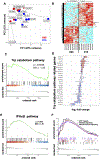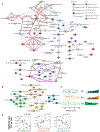Metabolic adaptation of ovarian tumors in patients treated with an IDO1 inhibitor constrains antitumor immune responses
- PMID: 35294258
- PMCID: PMC9311231
- DOI: 10.1126/scitranslmed.abg8402
Metabolic adaptation of ovarian tumors in patients treated with an IDO1 inhibitor constrains antitumor immune responses
Abstract
To uncover underlying mechanisms associated with failure of indoleamine 2,3-dioxygenase 1 (IDO1) blockade in clinical trials, we conducted a pilot, window-of-opportunity clinical study in 17 patients with newly diagnosed advanced high-grade serous ovarian cancer before their standard tumor debulking surgery. Patients were treated with the IDO1 inhibitor epacadostat, and immunologic, transcriptomic, and metabolomic characterization of the tumor microenvironment was undertaken in baseline and posttreatment tumor biopsies. IDO1 inhibition resulted in efficient blockade of the kynurenine pathway of tryptophan degradation and was accompanied by a metabolic adaptation that shunted tryptophan catabolism toward the serotonin pathway. This resulted in elevated nicotinamide adenine dinucleotide (NAD+), which reduced T cell proliferation and function. Because NAD+ metabolites could be ligands for purinergic receptors, we investigated the impact of blocking purinergic receptors in the presence or absence of NAD+ on T cell proliferation and function in our mouse model. We demonstrated that A2a and A2b purinergic receptor antagonists, SCH58261 or PSB1115, respectively, rescued NAD+-mediated suppression of T cell proliferation and function. Combining IDO1 inhibition and A2a/A2b receptor blockade improved survival and boosted the antitumor immune signature in mice with IDO1 overexpressing ovarian cancer. These findings elucidate the downstream adaptive metabolic consequences of IDO1 blockade in ovarian cancers that may undermine antitumor T cell responses in the tumor microenvironment.
Conflict of interest statement
Figures







References
-
- Uyttenhove C, Pilotte L, Theate I, Stroobant V, Colau D, Parmentier N, Boon T, Van den Eynde BJ, Evidence for a tumoral immune resistance mechanism based on tryptophan degradation by indoleamine 2,3-dioxygenase, Nat Med 9, 1269–1274 (2003). - PubMed
-
- Munn DH, Sharma MD, Baban B, Harding HP, Zhang Y, Ron D, Mellor AL, GCN2 kinase in T cells mediates proliferative arrest and anergy induction in response to indoleamine 2,3-dioxygenase, Immunity 22, 633–642 (2005). - PubMed
-
- Fallarino F, Grohmann U, Hwang KW, Orabona C, Vacca C, Bianchi R, Belladonna ML, Fioretti MC, Alegre ML, Puccetti P, Modulation of tryptophan catabolism by regulatory T cells, Nat Immunol 4, 1206–1212 (2003). - PubMed
Publication types
MeSH terms
Substances
Grants and funding
- U24 CA274159/CA/NCI NIH HHS/United States
- P30 CA016056/CA/NCI NIH HHS/United States
- U01 CA214263/CA/NCI NIH HHS/United States
- P30 CA014599/CA/NCI NIH HHS/United States
- UM1 CA154967/CA/NCI NIH HHS/United States
- P30 CA125123/CA/NCI NIH HHS/United States
- U01 CA233085/CA/NCI NIH HHS/United States
- R01 CA216426/CA/NCI NIH HHS/United States
- U01 CA154967/CA/NCI NIH HHS/United States
- U24 CA232979/CA/NCI NIH HHS/United States
- P50 CA159981/CA/NCI NIH HHS/United States
- P30 CA015704/CA/NCI NIH HHS/United States
- R01 CA220297/CA/NCI NIH HHS/United States
LinkOut - more resources
Full Text Sources
Medical
Molecular Biology Databases
Research Materials

